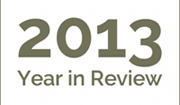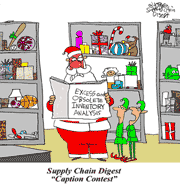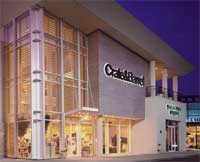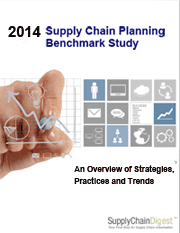 |
January 10, 2014 - Supply Chain Flagship Newsletter |
 |
| THIS WEEK'S SPONSOR: APICS |
 |
 |
|
|||||||||||||||||||||||||||||||||||||||||||||||||||||||||||||||||||||||||||||||||
The Year in Supply Chain 2013
|
||||||||||||||||||||||||||||||||||||||||||||||||||||||||||||||||||||||||||||||||||
| GILMORE SAYS: |
"The horse meat scandal led grocery chain Sainsbury's to say it would do expensive DNA testing on all incoming meat shipments, and us to say that in the future, it won't just be about food safety, but also food integrity" WHAT DO YOU SAY? |
The Euro zone troubles
continued on, with total growth expected to be flat or down a bit for
the full year, with the current fear now being deflation, or falling
prices, which the central banks there are working hard to avoid, as
consumer and business demand remains weak.
China is expected to post
official full year GDP growth of 7.6%, the lowest since 1999. But many
feel the official numbers are tilted to the upside of reality. Japan's
stock market at last took off after an aggressive US-style quantitative
easing program was launched, but whether the economy there will rally
after years of stagnation is unclear.
The world overall became a
more risky place, with continued troubles in the Middle East (Iran nuke
concerns, a coup in Egypt, Syrian civil war) that as always could
escalate to something more at any time. Perhaps more troubling were
growing tensions - and clear Chinese aggressiveness - over disputes with
Japan, the Philippines, South Korea and more over control of various
tiny islands, parts of the Pacific ocean, and even airspace. This is
real potential trouble.
On core supply chain, the
e-fulfillment wars certainly occupied center stage for most of 2013,
with Amazon.com leading the charge, with its plans or tests for a roll
out of its on-line grocery business, co-locating mini-fulfillment
centers inside some customer DCs, expansion of its locker service,
Sunday deliveries in some markets, the now famous research into using
drones for delivery, plans for a "center aisle" grocery offering to take
on warehouse clubs, and more - in one year.
Meanwhile, Macy's rolled out
store based e-fulfillment capabilities while Walmart aggressively
piloted the same concept. eBay announced tests around a same day
fulfillment service with a broad group of retail partners, among other
announcements this year. Google also started testing the delivery
service waters. Retailers and manufacturers are investing big money to
avoid being "Amazoned." (My friend Jim Tompkins may have invented that term.)
Also very big news this year
was the US energy boom, led by fracking techniques to produce both oil
and natural gas, leading to economic surges in parts of the country such
as North Dakota. US reliance on foreign energy sources is dropping
rapidly, with real energy independence clearly now a clear possibility.
In 2013, the US actually
passed Russia to be number 1 in the world in total oil and gas
production, a transformation very few saw coming even a few years ago.
That domestic energy boom
strongly contributed to the view that US manufacturing really is making
something of a comeback. The US has very low natural gas prices compared
to most of the rest of the world, leading a resurgence of sorts in gas
intensive industries, such as chemicals and metals. The first new
US-based fertilizer plant in 20 years is being constructed in Iowa,
based on low nat gas prices.
 Meanwhile, Walmart held a
major event looking for suppliers which make their products in America
(talk about "retro" - remember its failed "made in the America" campaign
of 20 years ago?), while the US is even seeing a return of some textile
and apparel mills, among other anecdotes. This trend hasn't really
showed up much yet in the aggregate numbers, but the news was still
encouraging.
Meanwhile, Walmart held a
major event looking for suppliers which make their products in America
(talk about "retro" - remember its failed "made in the America" campaign
of 20 years ago?), while the US is even seeing a return of some textile
and apparel mills, among other anecdotes. This trend hasn't really
showed up much yet in the aggregate numbers, but the news was still
encouraging.
Commodity prices continued
to take a beating, as the long commodity price surge that had companies
around the world concerned with growing input costs for years is
seemingly over for now. The Dow Jones-UBS Commodity Index, for example,
fell 9.6% in 2013, the third consecutive annual loss for the measure.
Slowing demand from China in the past few years is a key factor.
Oil prices, however,
remained basically flat, ending the year at about the same $95 level for
West Texas Crude as began the year. But with a few exceptions input
cost pressures are low right now.
In April, the collapse of a
building in Bangladesh that housed several apparel factories killed more
than 1100 workers, and along with earlier fires there and in Pakistan
exposed the tangled and murky supply chain networks in the apparel and
textile sectors. This was in fact a real eye opener - tons of
sub-contracting going on by direct suppliers to big retailers and brands
because they could not meet volume commitments on their own, and the
retailers either were unaware or I believe simply looked the other way
until the tragedies.
Competing plans to help
Bangladeshi suppliers were announced by Euro and US retailers and brand
companies (the Euro plan was more generous), and companies such as
Walmart toughened supplier policies relative to sub-contracting and
other practices, though I think the issues are hardly solved.
Use of Cloud-based supply
chain software seemed to really gain critical mass in 2013, with SAP,
Oracle and JDA among others announcing major initiatives, and seemingly
every new software entrant offering Cloud- based solutions. Cloud
gained traction even in such areas as supply chain planning and
Warehouse Management, where progress had been slow. The corner is being
turned.
The feared Hours of Service
changes for US truck drivers survived a court challenge and went into
effect July 1, but as a few brave souls had predicted, the impact seems
to be well below the levels some feared, and really felt only on long
haul, cross country routes.
While some had estimated a
mid to upper single digit hit to productivity, most carriers are saying
the aggregate impact is in the low single digits, and the issue had
really faded from prominence as the year ended.
Finally, earlier in the year
came the at times humorous but in reality serious issue of horse meat
being substituted for what consumers thought to be beef in hamburgers on
UK grocery cases all the way to Ikea frozen meat balls.
The led grocery chain
Sainsbury's to say it would do expensive DNA testing on all incoming
meat shipments, and us to say that in the future, it won't just be about
food safety, but also food integrity.
As usual, it was an
interesting and challenging year in the supply chain. I expect more of
the same in 2014. Look for the event timeline in OnTarget next
Wednesday.
If I missed any key themes
or story lines for 2013, let me know.
Any key trends or themes or storyline you think were key in 2013? Let us know your thoughts at the Feedback button or section below
| View Web/Printable Version of this Page |
|
|
|
YOUR FEEDBACK
We received a number of nice letters on our Supply Chain Christmas Carol for 2013. A sampling is below. Thanks to all.
Feedback on A Supply Chain Christmas Carol 2013
I loved the Supply Chain Christmas Carol - especially the kids asking "What's supply chain again?" - that made me laugh since I experience that all the time. Let me know the website link and I'll direct people to it. Alex Fuller |
||
Love it. Very clever, creative and informative! Merry Christmas! Shelley Nobcessory |
||
Brilliant as always. I love how you don't just reuse something from the past, but update it and improve it. Excellent. David Coater |
||
I am simply very impressed by Dan's wit. I have seen several attempts in other areas (nothing to do with supply chain) try to do take offs on the Christmas Carol storyline, and none in my opinion have been as good as the SCDigest version relative to supply chain. Great job - I shared with many in my office. Anna Marie Dimengo |
SUPPLY CHAIN TRIVIA ANSWER
Q: In honor of Art Mesher's recent retirement as CEO of Descartes, what are the three V's of supply chain?
A: As defined in a series of famous research notes when Mesher was at Gartner about 1997: visibility, velocity, and variability.
| © SupplyChainDigest™ 2003-2013. All Rights Reserved. SupplyChainDigest PO Box 714 Springboro, Ohio 45066 |
POWERED BY: XDIMENSION
|









